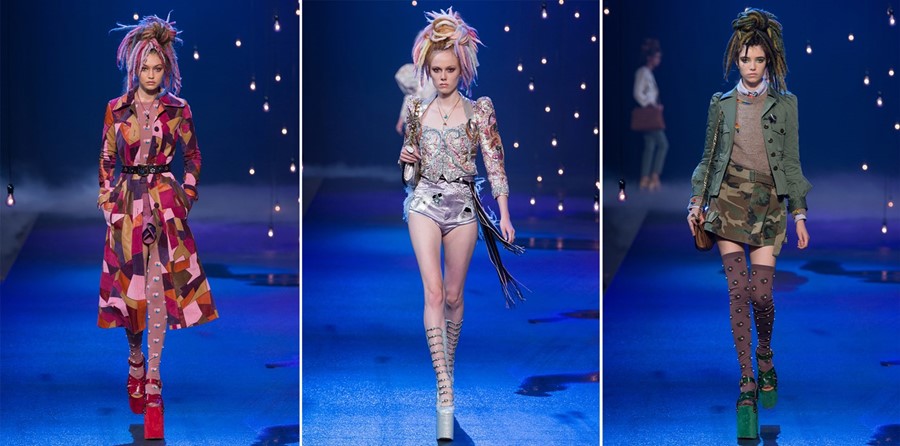The score which accompanies creative omnivore Marc Jacobs' shows each season is part and parcel of his collection. We consider the meanings hidden in five of his most memorable soundtracks yet
Apple MusicA Marc Jacobs show is always a fashion week highlight, a stalwart on each season’s schedule. There are a few things you can rely on: unpredictable clothes that speak to how we want to dress now, a kind of sensitive perception of the cultural mood, and of course, a pumping soundtrack. For Jacobs it’s simple: his interests don’t start and end with dresses and hemlines. Think of him instead as a kind of creative omnivore, in tune with the sound of a downtown Manhattan club as much as in the women who frequent it. What emerges each season is the clearest distillation of a specific mood.
Inevitably, the music is more than just background dressing; it’s essential to Jacobs’ conception of his woman within each collection – a fact which makes his new collaboration with Apple Music, for which he has curated a personal playlist and featured additional playlists from the stars of his Autumn/Winter 2016 campaign, including Kendall Jenner, Missy Elliot and Susan Sarandon, under his curator profile – all the more exciting. Here, we examine the musical inspiration behind five of his most memorable shows.
Spring/Summer 2017
How do you express devil-may-care hedonism most accurately? To answer this question with his most recent collection, for Spring 2017, Jacobs landed on rave culture. With Underworld’s club anthem Born Slippy, itself a byword for nights of endless pleasure-seeking, playing in the background, the models walked out in metallic pastels, miniskirts and chunky heels, ready for their own rave moment in the spotlight. This collection was the pursuit of pleasure writ large, in snakeskin and pearlescent embellishment. Amid a sea of twinkling lightbulbs, the cumulative effect of the show was glittering and hazy, like the morning-after memory of a night spent on the dancefloor.
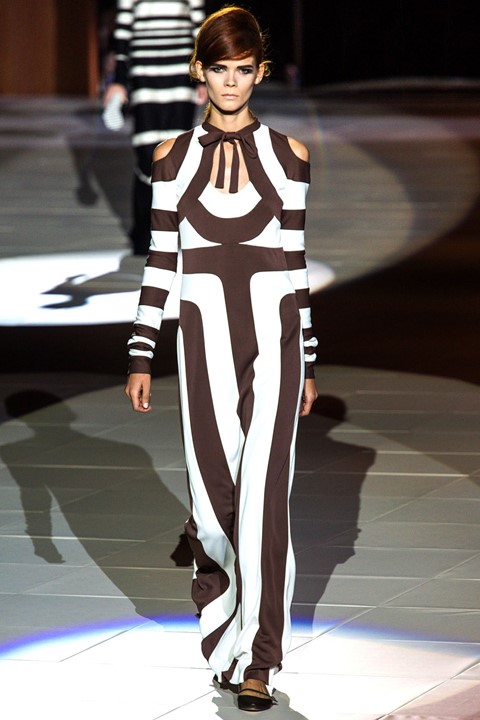
Spring/Summer 2013
A cursory stroll through downtown Manhattan will assure you of Marc Jacobs’ indelible link to New York cool – swinging shopping bags on the arms of SoHo shoppers, billboards on Bleecker St. A crucial part of how he maintains that year after year is by looking back at previous incarnations of what it means to be It in the city. For Spring 2013, that meant looking to Andy Warhol’s Factory to channel the laissez-faire cool of the Velvet Underground, Edie Sedgwick and their milieu. The modern update of this consisted of stripped-back monochrome stripes, long pleated skirts and silhouette-skimming separates, all soundtracked by the jangling post-punk of The Fall’s 1980s hit Copped It.
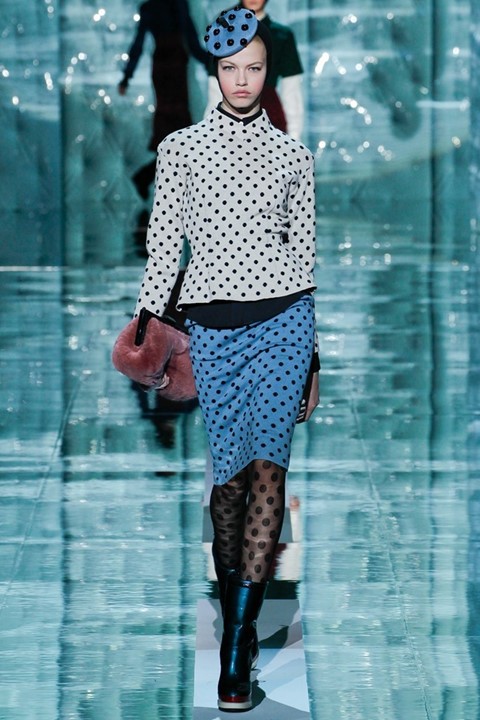
Autumn/Winter 2011
Part of what always appeals about a Marc Jacobs show for editors and buyers is the temptation of the unpredictable. In 2011, he bucked expectations by embracing rigour, with a collection centred on latex, bindings and wiggle skirts. He furthered the almost cartoonish emphasis on feminine sexuality with a healthy dose of polka dots and embossed fabrics throughout. The soundtrack? Marilyn Manson’s 1996 single The Beautiful People, an anthem for the disaffected and for those disillusioned with what Manson calls “the fascism of beauty.” The overall result was startling, provocative and more complex than the straightforward fun often seen on a Marc Jacobs runway.
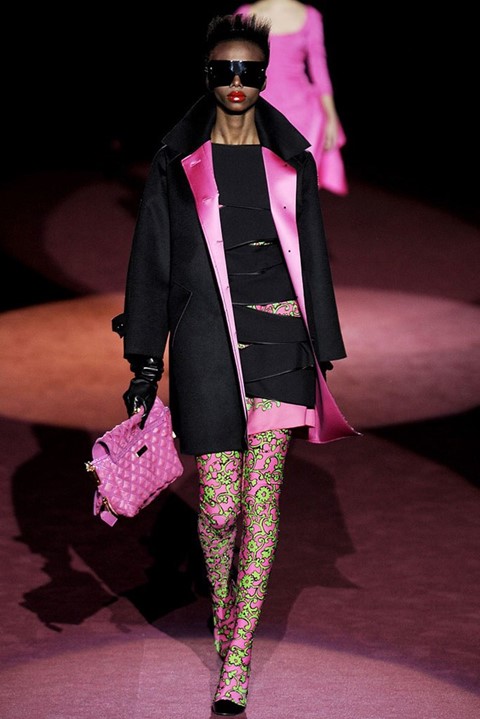
Autumn/Winter 2009
At a time when New York was still flattened by financial crisis and a general sense of ennui, Marc Jacobs brought us back to our senses. Fall 2009 offered a greatest hits of downtown party looks inspired by what he called “the good old days… when getting dressed up was a joy.” This was an exuberant romp through the wardrobe of a 1980s party girl as she gets ready for a night out. Dressed in velvet and metallic leather, with big, backcombed hair, her soundtrack came from Spinnerette, the punk band headed up by Brody Dalle of the Distillers, another favourite of the designer. Songs like Valium Knights and Ghetto Love injected a certain hedonism and merriment to the proceedings, at a time when the fate – and the purpose – of luxury fashion seemed precarious.
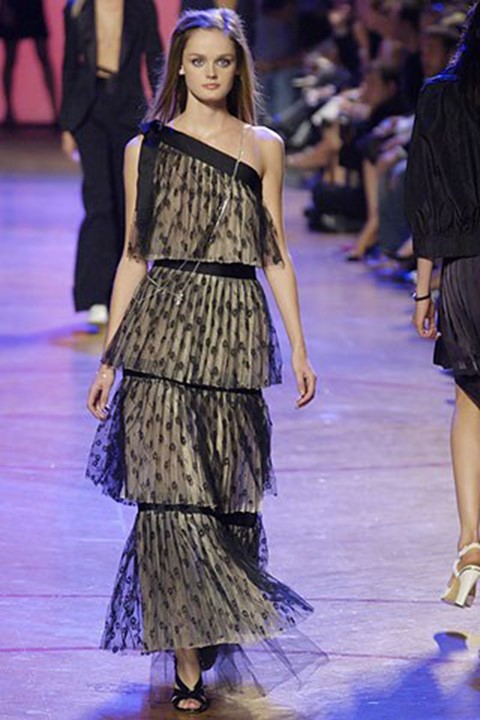
Spring/Summer 2006
Consider Spring 2006 a harking back to Jacobs' roots and to the Spring 1993 collection for Perry Ellis, the grunge-inspired collection that cost him his job at the American fashion house. The collection of luxury flannel-like silk shirts and chiffon check dresses had its share of detractors at the time but has since been somewhat venerated as a pivotal point in style history. In 2006, Marc called upon the Penn State University marching band to perform a raucous rendition of Nirvana’s Smells Like Teen Spirit as proceedings got underway. The collection that followed – of shimmering cocktail dresses and oversized outerwear - showed how far Marc had come since those Perry Ellis days, but also that he is still the same innovative designer beneath it all. This was not the first time the song had cropped up in a Marc Jacobs show soundtrack, but never before had it sounded so joyous and celebratory.
